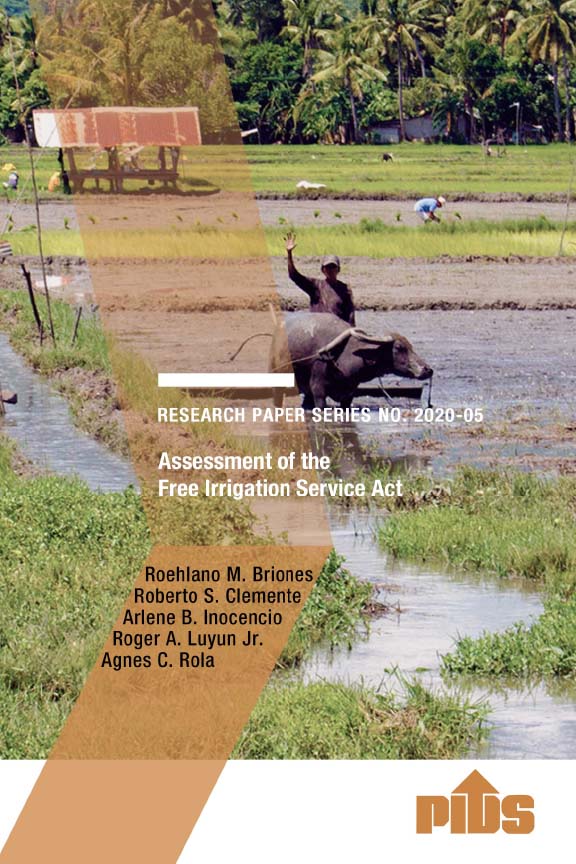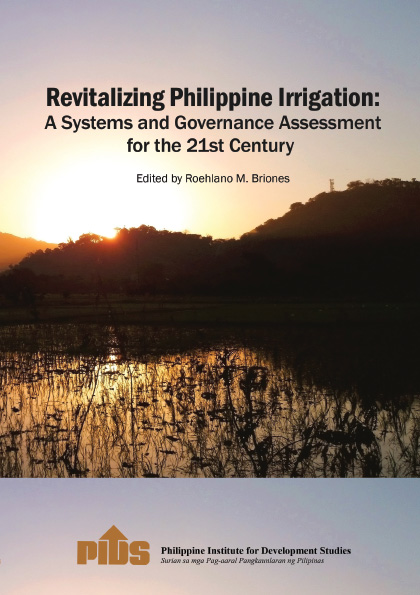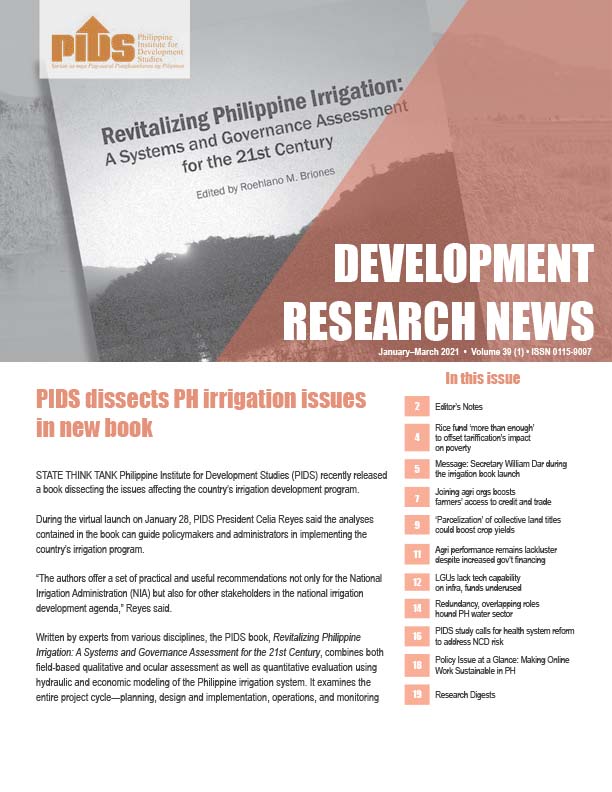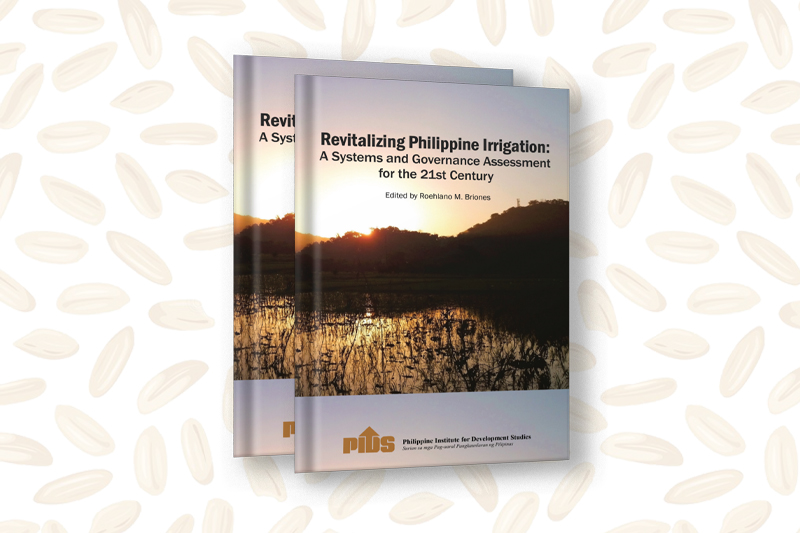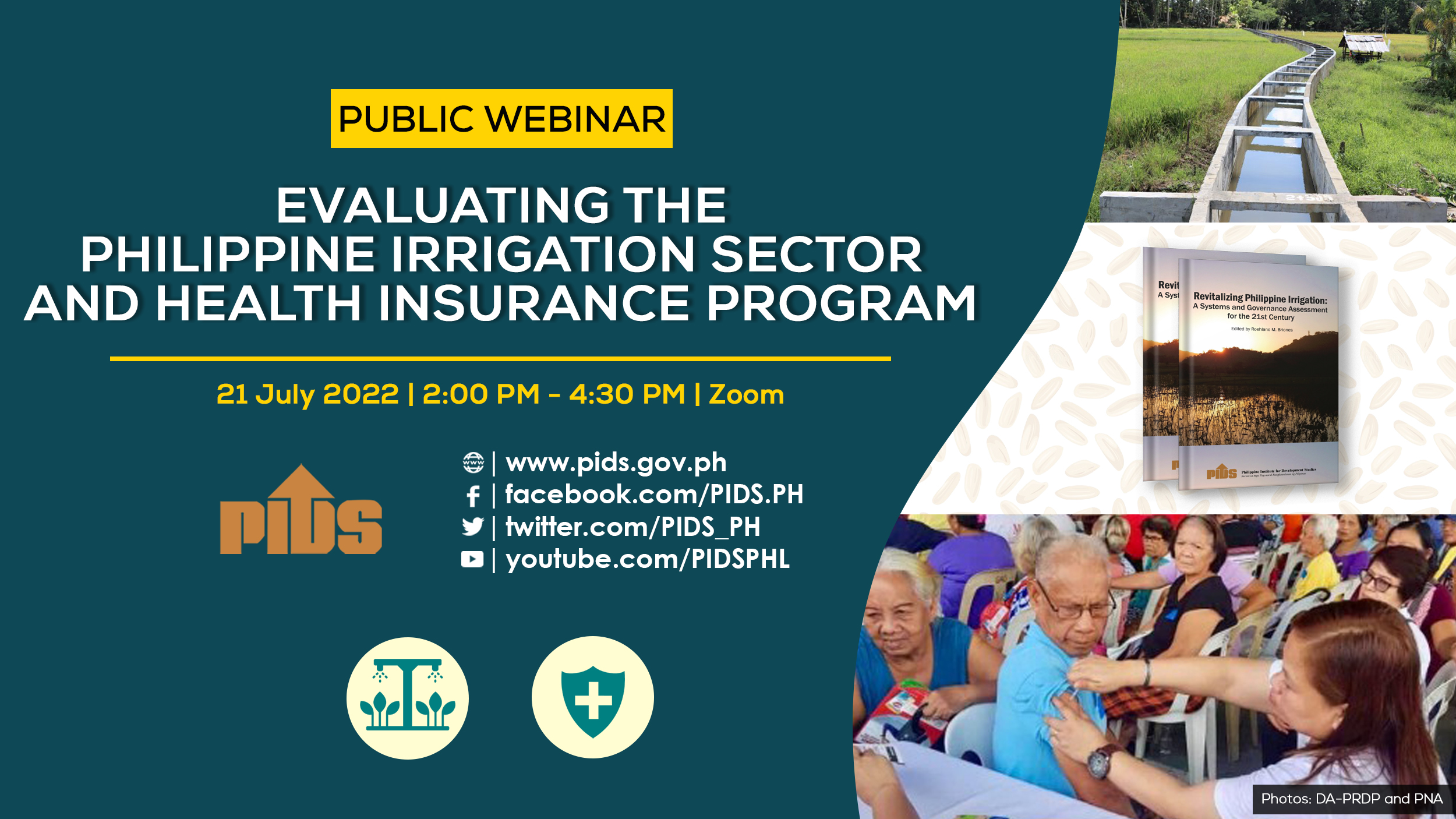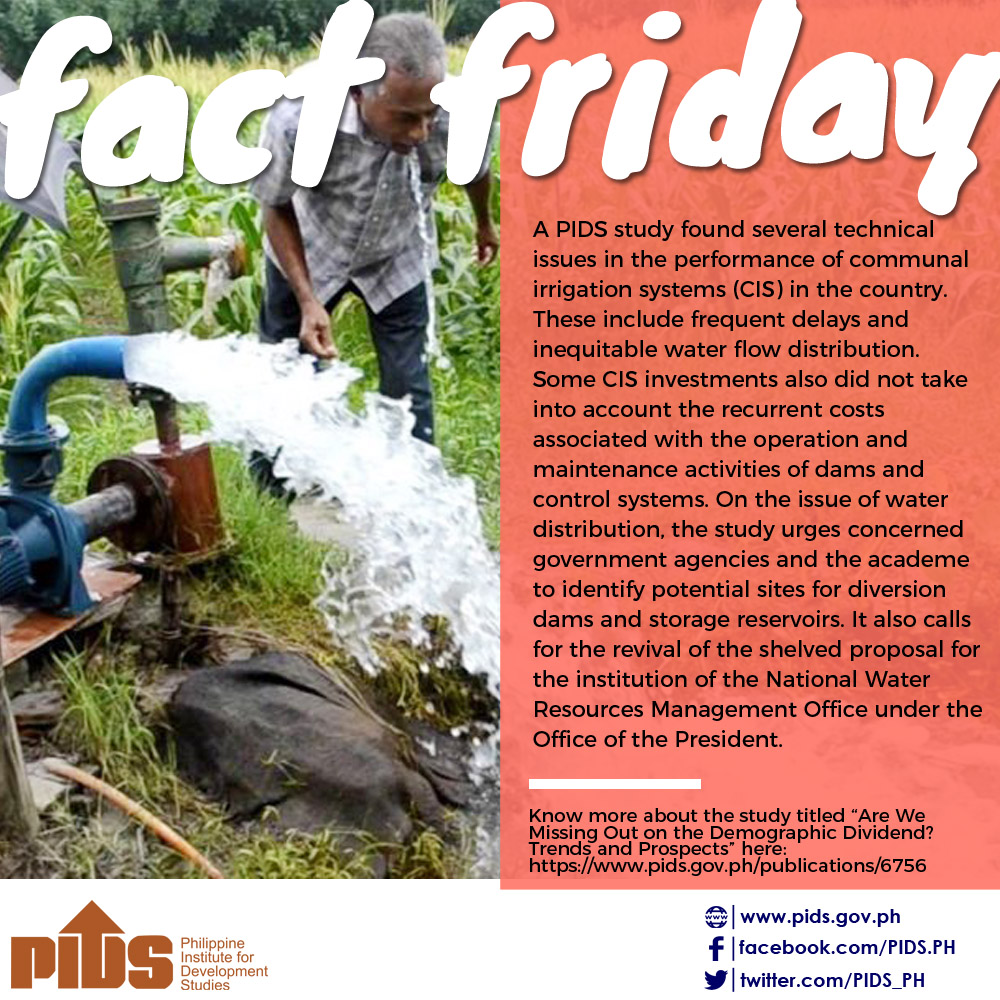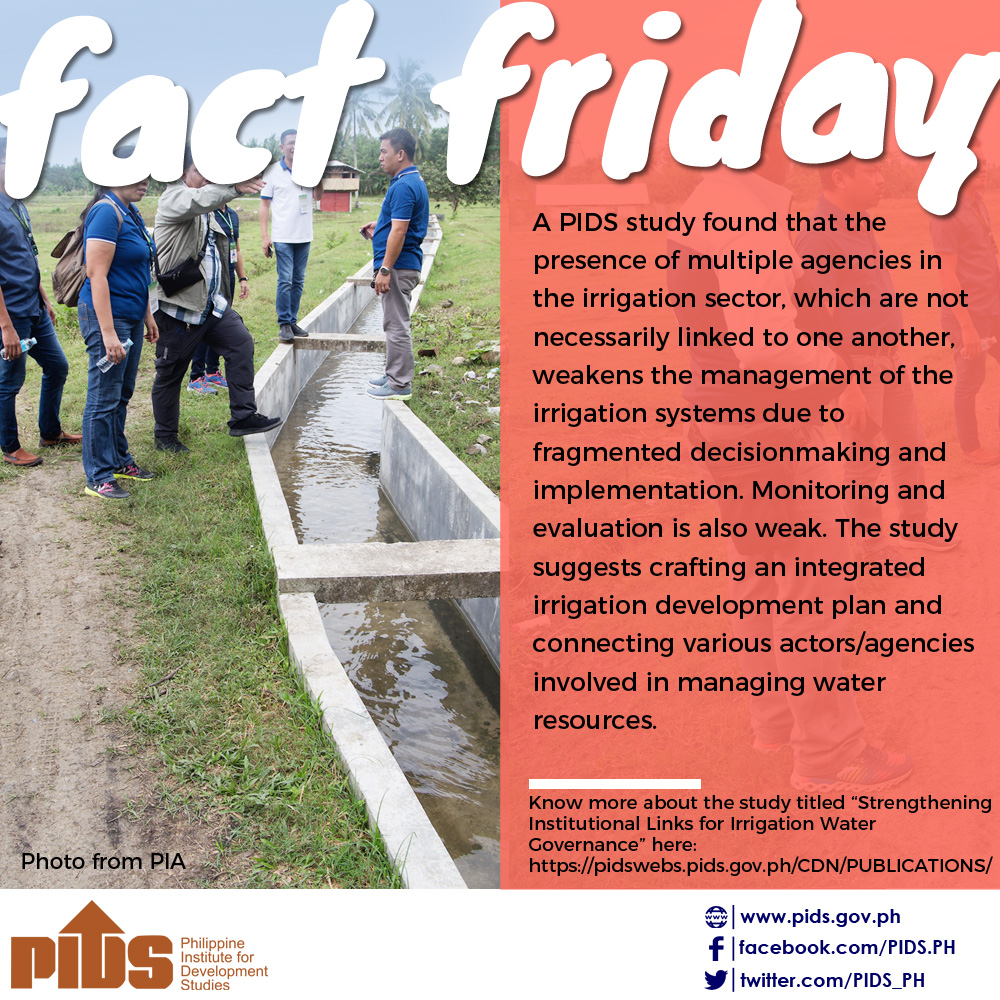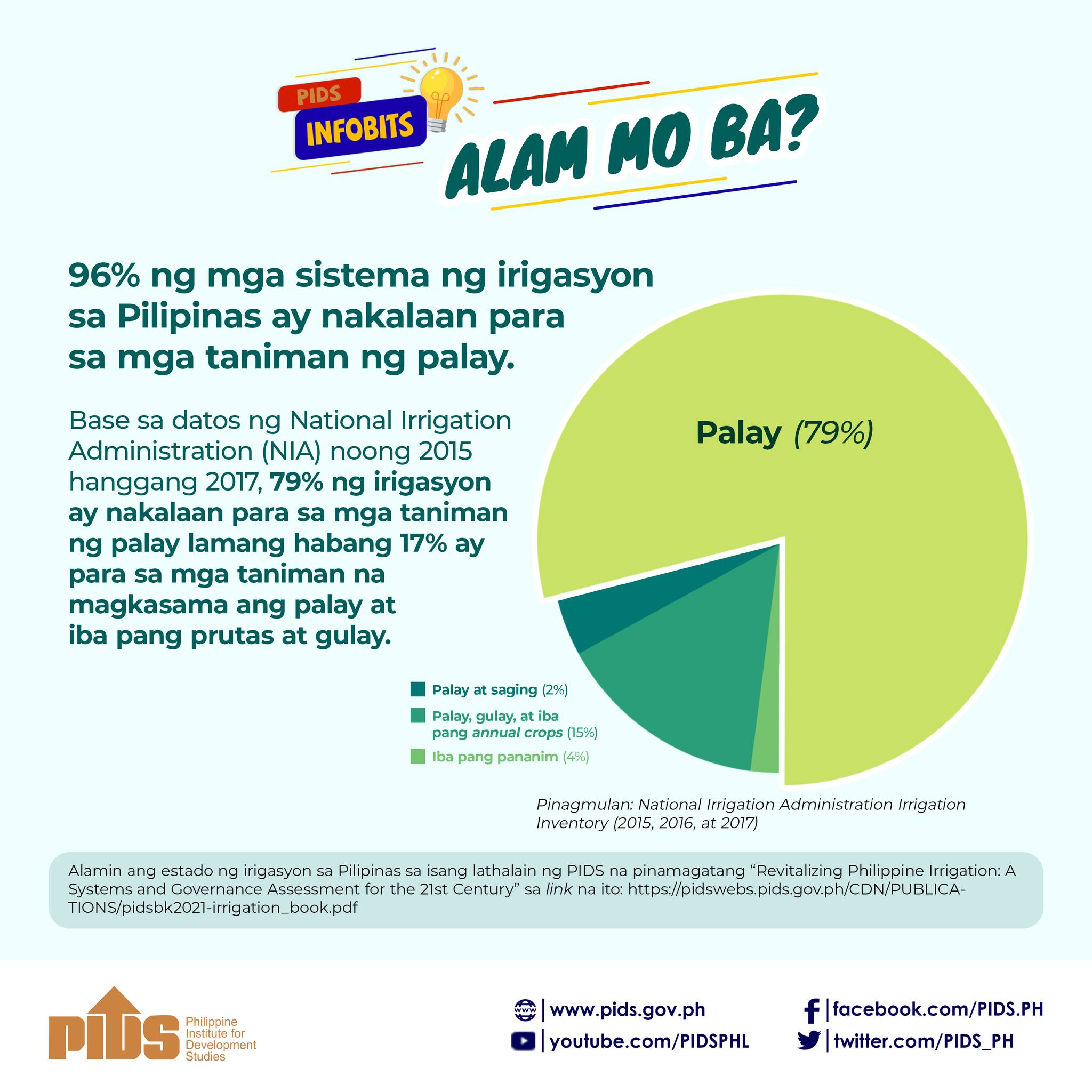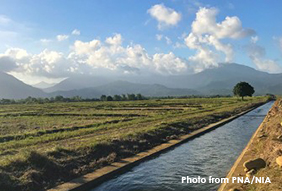
Targets for irrigation development are “hardly met” despite massive increases in funding recently, according to a study published by state think tank Philippine Institute for Development Studies (PIDS).
The country plans to expand its irrigated area by 7.74 percent by 2022, as part of its efforts to achieve the inclusive growth vision under the Philippine Development Plan (PDP) 2017-2022. The expansion is seen to increase production and farm incomes, subsequently increasing the cropping intensity or the ratio of total irrigated areas in two seasons to that of the dry season from 144 percent to 157 percent.
To achieve these targets, budget allocations to the National Irrigation Administration (NIA) have been increased in the General Appropriations Act (GAA). The study noted that from mere PHP 8 million in 2008, the funding for irrigation ballooned to PHP 41.7 million in 2018, accounting for over 40 percent of the total allocation for the agriculture sector. Furthermore, the PDP mandated NIA to invest PHP 71.8 billion for the construction of small reservoir irrigation projects and PHP 31.3 billion for the repair and rehabilitation of existing communal irrigation systems.
The increase in GAA allocation, however, “does not guarantee achievements of these targets”, according to authors Arlene Inocencio and Roehlano Briones, PIDS consultant and PIDS senior research fellow, respectively.
“Despite the increase in allocation, NIA has hardly met its annual physical targets for new area development,” the authors said, adding that this may be attributed to institutional, physical, and operational constraints faced by the agency.
Among the institutional factors identified is the decline in the capacities of various units of NIA due to its rationalization plan, putting them in a situation wherein capacities in critical functions do not match the requirements needed to meet the targets.
The authors mentioned typhoons and the rainy season as physical factors limiting the window for project implementation. For the operational factor, they pointed out that repairs and rehabilitation cannot be done in between seasons, which meant reduced period for project implementation.
“The trends in actual versus target irrigated area have been generally below 100 percent. This means that NIA never got to realize its new target area, except in 1997,” the authors noted, adding that “its accomplishment was even 50 percent or less in 16 years of the 29 year-period data.”
NIA also raised another issue concerning the rapid conversion of irrigated lands into nonagricultural uses, “putting to waste irrigation investments poured into these lands”.
Data from the agency showed that Central Luzon has the largest converted irrigated area of about 12,000 hectares in 2017, while provinces with land conversion in 2010 include Bulacan, Isabela, Palawan, Iloilo, Nueva Ecija, and Pampanga. In Mindanao, the provinces of Bukidnon, Zamboanga del Sur, South Cotabato, and Sultan Kudarat had converted over 2000 hectares of land each.
The study pointed out that while these conversions only cover three percent of the total service area since 2010, these might have cost the government about PHP 14 billion, assuming a modest average investment cost per hectare of PHP 300,000.
“With this conversion, the public investment is effectively wasted,” the authors said.
Meanwhile, the study also identified other issues that have “serious implications” in irrigation development. Based on 2017 data from NIA, the authors found that the ratios of nonoperational areas have remained above 20 percent, despite an annual reduction of 8,600 hectares between 2010 and 2017.
With these observations, the study said the government may opt to proceed with restoration first, before investing in new areas.
Furthermore, as the Rice Liberalization Act lowers domestic rice prices, “the Rice Roadmap 2030 projects that more farms will no longer be viable and will be getting out of rice production.” This could lead to an increase in investments for nonrice irrigation and crop diversification. However, between 2014 and 2017, the study said that the irrigation for nonrice areas hardly changed and remained negligible relative to total irrigated rice area.
“This observation implies that if the new irrigation masterplan and rice roadmaps are serious in their intent to increase irrigation of diversified areas, the government has to take more drastic actions,” the study explained.
It urged the government to research on areas more suitable for nonrice crops and explore various technologies that would best complement crop diversification. ###
This press release is based on PIDS policy note titled, “Irrigation investments: Some recurrent and emerging issues”.
The country plans to expand its irrigated area by 7.74 percent by 2022, as part of its efforts to achieve the inclusive growth vision under the Philippine Development Plan (PDP) 2017-2022. The expansion is seen to increase production and farm incomes, subsequently increasing the cropping intensity or the ratio of total irrigated areas in two seasons to that of the dry season from 144 percent to 157 percent.
To achieve these targets, budget allocations to the National Irrigation Administration (NIA) have been increased in the General Appropriations Act (GAA). The study noted that from mere PHP 8 million in 2008, the funding for irrigation ballooned to PHP 41.7 million in 2018, accounting for over 40 percent of the total allocation for the agriculture sector. Furthermore, the PDP mandated NIA to invest PHP 71.8 billion for the construction of small reservoir irrigation projects and PHP 31.3 billion for the repair and rehabilitation of existing communal irrigation systems.
The increase in GAA allocation, however, “does not guarantee achievements of these targets”, according to authors Arlene Inocencio and Roehlano Briones, PIDS consultant and PIDS senior research fellow, respectively.
“Despite the increase in allocation, NIA has hardly met its annual physical targets for new area development,” the authors said, adding that this may be attributed to institutional, physical, and operational constraints faced by the agency.
Among the institutional factors identified is the decline in the capacities of various units of NIA due to its rationalization plan, putting them in a situation wherein capacities in critical functions do not match the requirements needed to meet the targets.
The authors mentioned typhoons and the rainy season as physical factors limiting the window for project implementation. For the operational factor, they pointed out that repairs and rehabilitation cannot be done in between seasons, which meant reduced period for project implementation.
“The trends in actual versus target irrigated area have been generally below 100 percent. This means that NIA never got to realize its new target area, except in 1997,” the authors noted, adding that “its accomplishment was even 50 percent or less in 16 years of the 29 year-period data.”
NIA also raised another issue concerning the rapid conversion of irrigated lands into nonagricultural uses, “putting to waste irrigation investments poured into these lands”.
Data from the agency showed that Central Luzon has the largest converted irrigated area of about 12,000 hectares in 2017, while provinces with land conversion in 2010 include Bulacan, Isabela, Palawan, Iloilo, Nueva Ecija, and Pampanga. In Mindanao, the provinces of Bukidnon, Zamboanga del Sur, South Cotabato, and Sultan Kudarat had converted over 2000 hectares of land each.
The study pointed out that while these conversions only cover three percent of the total service area since 2010, these might have cost the government about PHP 14 billion, assuming a modest average investment cost per hectare of PHP 300,000.
“With this conversion, the public investment is effectively wasted,” the authors said.
Meanwhile, the study also identified other issues that have “serious implications” in irrigation development. Based on 2017 data from NIA, the authors found that the ratios of nonoperational areas have remained above 20 percent, despite an annual reduction of 8,600 hectares between 2010 and 2017.
With these observations, the study said the government may opt to proceed with restoration first, before investing in new areas.
Furthermore, as the Rice Liberalization Act lowers domestic rice prices, “the Rice Roadmap 2030 projects that more farms will no longer be viable and will be getting out of rice production.” This could lead to an increase in investments for nonrice irrigation and crop diversification. However, between 2014 and 2017, the study said that the irrigation for nonrice areas hardly changed and remained negligible relative to total irrigated rice area.
“This observation implies that if the new irrigation masterplan and rice roadmaps are serious in their intent to increase irrigation of diversified areas, the government has to take more drastic actions,” the study explained.
It urged the government to research on areas more suitable for nonrice crops and explore various technologies that would best complement crop diversification. ###
This press release is based on PIDS policy note titled, “Irrigation investments: Some recurrent and emerging issues”.

